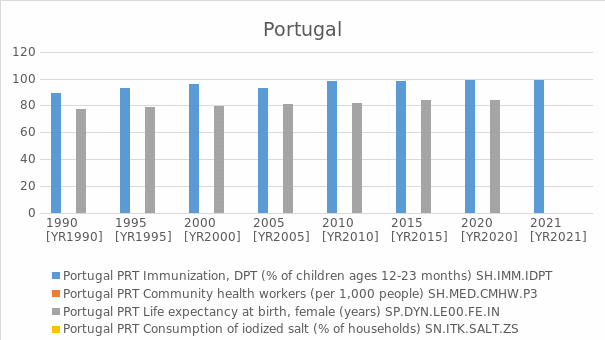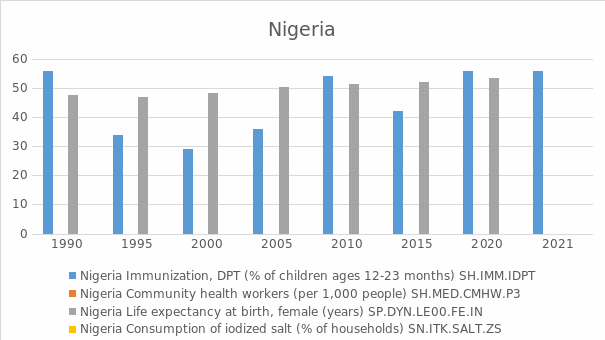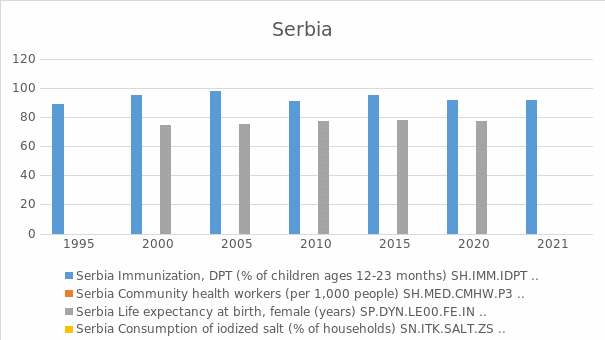The Purpose of the Note
Throughout the last 25 years, this briefing paper examines people’s general health in nations with high, upper-middle, lower-middle, and low incomes. This was accomplished by analyzing information from Global Development Indicators to provide a complete picture of the population’s health across all four income brackets. The report will take into consideration Ethiopia, Serbia, Portugal and Nigeria. Data will be taken and summarized to generate figures and charts from the World development indicators website.
The Aim of the Note to the Relevant Sustainable Development Goal
This briefing supports the Goal of sustainable development 3: Promote healthy lifestyles and well-being for all ages. This note’s data supports the following goals: 3.1: By 2030, reduce global maternal mortality to less than 70 per 100,000 live births (DataBank, 2023). Furthermore, before 2030, eliminate preventable deaths of newborns and children under five, with all countries aiming to reduce neonatal mortality to at least 12 per 1,000 live births and under-5 mortality to at least 25 per 1,000.
From the Global Development Indicators Database, the worldwide infant mortality rate per 1,000 live births in 2020 was 38, with 216 pregnancy-related maternal deaths per 100,000 live births, 39 under-5 deaths per 1,000 live births, and 72.4 average life expectancy at birth years (DataBank, 2023). The infant mortality rate per 1,000 live births in the United States was 5.7, the rate of pregnancy-related maternal deaths per 100,000 live births was 17.4(DataBank, 2023). The rate of under-5 deaths per 1,000. As indicated from the DataBank (2023) live births was 5.8, and the average life expectancy at birth years was 78.9.
The four main health metrics used to evaluate nation groups’ health are, the infant mortality rate per 1,000 live births is a health indicator. It is an excellent measure of population health and may be used to compare national health performance. Pregnancy-related maternal deaths per 100,000 live births. It may be used to compare nation health performance and healthcare system quality. The rate of under-5 deaths per 1,000 live births may be used to compare nation health performance (DataBank, 2023). If mortality rates continue, a newborn will live LEB years this makes it a key health indicator that may be used to compare nation groupings.
The Issues and the Data on the Chosen Indicators
The four nations and various indices show a substantial health discrepancy between low-income countries like Ethiopia and higher-income ones like Portugal. In 2021, 65% of Ethiopian 12-23-month-olds were vaccinated, compared to 99% in Portugal (DataBank, 2023). Ethiopia’s 2020 birth life expectancy was 68.426 years, compared to Portugal’s 84.1, as shown in Figures 1 and 4. Ethiopia lacks community health experts, but Portugal does, exacerbating these differences, as shown in figure 4.
Ethiopia’s DPT immunization rate rose from 30% in 2000 to 65% in 2021, while iodized salt consumption rose from 28.4% in 2000 to 84.6% in 2015 as indicated in figure 4. Ethiopia’s health results are improving more slowly than in higher-income countries.
As depicted in Figures 2 and 1 Nigeria’s DPT vaccination rate in 2021 was 56%, compared to Portugal’s 99%, and its life expectancy at birth was 53.323 years, compared to 84.1 years in Portugal (DataBank, 2023). Serbia’s 2020 life expectancy was 77.2 years, compared to 84.1 years in Portugal, while its DPT vaccination rate in 2021 was 92%, compared to 99% in Portugal as shown in figure 1.
Policy Recommendation
Health and well-being results vary significantly between poor, lower-medium, upper-middle, and high-income countries. Serbia, Nigeria, and Portugal outperform Ethiopia in immunization, life expectancy, and community health workers (DataBank, 2023). Ethiopia uses less iodized salt than Serbia, Nigeria, and Portugal.
Ethiopia needs healthcare infrastructure and iodized salt to reduce health disparities and improve health outcomes. This issue can be solved by targeting Ethiopian healthcare systems and health education. Governments should engage in public health campaigns to educate women and families about the value of prenatal and postnatal care, as well as the hazards associated with not receiving these services.
Reference
DataBank, W. (2023). World development indicators. DataBank. Web.
Appendices
2021 Thresholds
Low Income (Ethiopia):
- Immunization, DPT (% of children ages 12-23 months): 65% (2021)
- Community health workers (per 1,000 people): 0.218 (2006)
- Life expectancy at birth, female (years): 68.795 (2020)
- Consumption of iodized salt (% of households): 84.6 (2016)
Lower Middle (Nigeria):
- Immunization, DPT (% of children ages 12-23 months): 56% (2021)
- Community health workers (per 1,000 people): 0.128 (2011)
- Life expectancy at birth, female (years): 53.323 (2020)
- Consumption of iodized salt (% of households): 93.3 (2019) (DataBank, 2023).
Upper Middle (Serbia):
- Immunization, DPT (% of children ages 12-23 months): 92% (2021)
- Community health workers (per 1,000 people): N/A
- Life expectancy at birth, female (years): 77.2 (2020)
- Consumption of iodized salt (% of households): N/A (DataBank, 2023).
High Income (Portugal):
- Immunization, DPT (% of children ages 12-23 months): 99% (2021)
- Community health workers (per 1,000 people): N/A
- Life expectancy at birth, female (years): 84.1 (2020)
- Consumption of iodized salt (% of households): N/A (DataBank, 2023).
The World Bank determines the thresholds for low, lower-middle, upper-middle, and high-income countries. They are based on various criteria, such as the country’s gross national income (GNI) per capita, GNI per capita growth, social and economic policies, and access to health care and education. The thresholds are used to classify countries into these four income categories and to determine their eligibility for certain types of foreign aid. The thresholds are also used to compare the level of development between countries. For example, the threshold for low-income countries is set at a GNI per capita of $1,045 or less, while the threshold for high-income countries is set at a GNI per capita of $12,536 or more (DataBank, 2023). This allows us to compare the development level between countries and determine which countries may need additional assistance.



